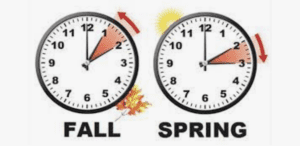
When is it?
This year, Daylight Saving Time begins on Sunday, March 12, 2023, and ends on Sunday, November 5, 2023.
What is it?
Our planet turns on its axis at an approximately 23.4 degree angle as it rotates around the sun. Both the northern and southern hemispheres lean towards the sun during their summer months and away from the sun during their winter months. Because of this, daylight hours decrease in the winter and increase in the summer. The equator generally maintains a regular 12 hours of daylight and 12 hours of darkness schedule year round. The further you are from the equator, the greater the decrease of light in the winter and the greater the increase of light in the summer.
Daylight saving time is the practice of setting the clocks ahead by one hour in the spring (spring forward) so that darkness falls at a later clock time during the warmer months, and setting the clocks back one hour in the fall (fall back) to return to standard time for the colder months. In the United States, Daylight Saving Time begins on the second Sunday of every March and ends the first Sunday of every November.
Why 2 a.m?
2 a.m. was chosen as the time for the change to occur because it is believed to be the time that has the least effect on the largest number of people as most people are expected to be home in bed.
Where did it begin?
Benjamin Franklin, in 1784, is credited as the first person to propose aligning waking hours with daylight hours in an attempt to conserve candle use and save money. More than 100 years later, in 1907, British citizen William Willet wrote a book titled The Waste of Daylight where he argued, “The sun shines upon the land for several hours each day while we are asleep, but there remains only a brief spell of declining daylight in which to spend the short period of leisure at our disposal.” It was Germany however, that was the first country to try it out in 1916 as a way to conserve coal usage during World War I. Daylight Saving Time was attempted in the United States in 1918 by President Woodrow Wilson and again in 1942 by President Franklin D. Roosevelt but it didn’t officially take hold nationwide until 1966 when President Lyndon Johnson signed a law making the start and end dates of Daylight Saving Time uniform across the county.
Why do we have it?
No, it does not have to do with the farmers. In fact, many farmers are opposed to Daylight Saving Time because it disrupts their carefully organized schedules. Dairy cows, for example, who are used to being milked at a certain time each morning, cannot understand having to wait an extra hour or start an hour earlier to release their milk. Six months later, just as the cows’ bodies have gotten used to it, they have to adjust again.
In most places, including the United States, Daylight Saving Time began as a way to conserve electricity during wartime. However, these days many studies show that the energy savings are insignificant, particularly considering that hotter climates are more likely to use air conditioning during the daytime. Today, people who support Daylight Saving Time generally do so because it allows for more activity in the evenings after work. People are much more likely to go outside and be social and active after work if it’s light out. Outdoor sports industries in particular cite more profits during Daylight Saving Time.
Some people who are against Daylight Saving Time believe it is bad for your health.
Some studies have linked “springing forward” to an increased risk of heart attack as well as immune impairment due to a decrease in sleep. Standard time on the other hand, which is when we move our clocks back in the fall, follows the sun’s day and night cycle more closely, which has set our circadian rhythm, or body clock, for centuries.
Some people who are for Daylight Saving Time believe it cuts down on car accidents and crime.
Most criminals prefer to work in the dark, particularly in the evening rather than the early morning hours. Advocates for Daylight Saving Time believe that creating more sunlight in the evening hours would prevent crime, particularly by juveniles who tend to be most active after school. They also believe it would cut down on car accidents since there are three times as many fatal car accidents in the dark evening hours than the early morning hours.
Sunshine Protection Act of 2021
In March of 2021, the United States Senate passed the Sunshine Protection Act of 2021, which if it becomes law would make Daylight Saving Time permanent. It has yet to come up for a vote.
What do you think?
Should we make Daylight Saving Time permanent and have more daylight year round? Or, should we stick to standard time? Fill out our survey here and let us know your opinion. Take our survey
